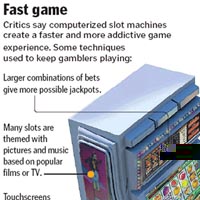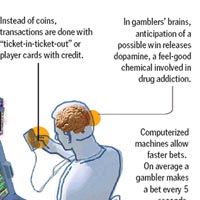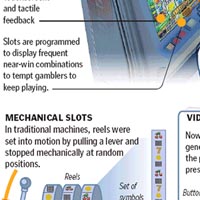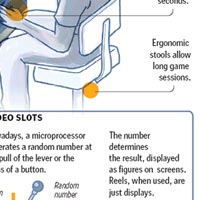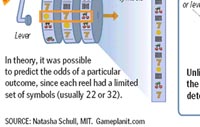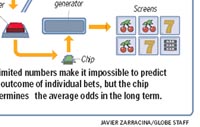| |
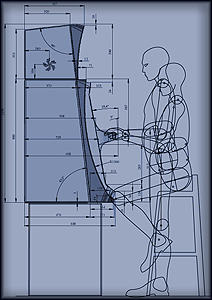
"It's important for voters to understand how these machines work. Every feature of a slot machine -- its mathematical structure, visual graphics, sound dynamics, seating and screen ergonomics -- is calibrated to increase a gambler's "time on device" and to encourage "play to extinction," which is industry jargon for playing until all your money is gone. The machines have evolved from handles and reels to buttons and screens, from coins to credit cards, from a few games a minute to hundreds. Inside, complicated algorithms perform a high-tech version of "loading the dice" -- deceptions no self-respecting casino would ever allow in table gambling. The machines are designed to exploit aspects of human psychology, and they do it well. In the eyes of the gaming industry, this may look like success, but it comes at great expense for gamblers."
-- Dr. Natasha Dow Schüll,
Assistant professor at MIT
and author of the soon-to-be-released book
Addiction by Design
Meet Your New Neighbor
How slot machines are secretly designed to seduce and destroy you, and how the government is in on it.
By Isaiah Thompson
Appearing in the Philadelphia City Paper
January 7, 2009
Slot machine gambling - which constitutes about 70 percent to 80 percent of all casino revenue - is, according to abundant and easily accessible research, the most addictive form of legalized gambling out there. It doesn't just attract addicts, some scholars suggest; it creates them.
Your brain on gambling
Science shows how slot machines take over your mind
By Jonah Lehrer
Appearing in the Boston Globe
August 19, 2007
research into dopamine's role in the brain, are helping neuroscientists understand the temptation of gambling and the scourge of gambling addiction. This research may also change the way we see casinos, and help shift the debate over whether the government should further regulate slots, roulette wheels, and other games of chance. From the perspective of the brain, gambling has much in common with addictive drugs, like cocaine. Both work by hijacking the brain's pleasure centers -- a lure that some people are literally incapable of resisting.
One of the big remaining questions for scientists is why only some gamblers get addicted. While most people can walk away from the slot machines, some gamblers, like Klinestiver, can't resist the temptation. For these compulsive gamblers, the misplaced predictions of their dopamine neurons become self-destructive. These people are so blinded by the pleasures of occasionally winning that they slowly lose everything.
Problem and pathological gambling do more than cause people to lose money and empty their bank accounts. The issue is wide reaching. In fact, much "like a stone thrown in the water, the ripple affect is felt along the shores".
To gain a better understanding of this issue, please view this short video revealing how the modern slot machine creates problem or pathological gambling addiction. The video features interviews with doctors, scholars and survivors of slot machine addiction.
This addiction ultimately harms children, families, senior citizens, returning veterans, our communities and local businesses, creates crime, spreads corruption and is expensive to regulate Ultimately, it causes competitive regional escalation and does not provide the benefits it promises.
Glitzy video slots seen as particular addiction risk
By Carey Goldberg / Globe Staff
Appearing in the Boston Globe
March 7, 2009
Among addiction specialists, video slot machines have come to be known as the "crack cocaine" of the gambling industry.
The mechanical wheels of spinning fruit used in the old one-armed bandits have gone the way of the typewriter. Modern-day slot machines are computerized sound-and-light shows so skillfully designed to keep players glued to their seats that some have been known to wear adult diapers to avoid bathroom breaks.
Continued...
As state Treasurer Timothy P. Cahill promotes the idea of licensing three slot parlors in Massachusetts, some mental health and gambling specialists warn that the newer machines deliver such potent gambling highs that they can be particularly addictive.
The video slots allow players to gamble incredibly rapidly, winning or losing a game every several seconds without a break, to the point that their brains are undergoing the equivalent of an intravenous drip of an intoxicating drug, said Bob Breen, director of the Rhode Island Hospital Gambling Treatment Program.
"When you sit in front of the slots, especially if it's 24/7, there are no cues for you to quit," he said. "There's no time to stop and think. You're getting that constant drip, and people describe it as being in the zone," he said.
The gaming industry defends the computerized slots, saying their widespread use has not led to increased addiction problems.
But in 15 years of clinical experience, Breen has found that gambling descends into pathology much more quickly among slots players than among people who bet on sports, races, cards, or lotteries.
It tends to take just a year, as opposed to up to five for other types of gambling, said Breen, who has published two studies that analyzed more than 200 addicted patients.
It is not only the speed of the games that makes so addictive the playing of new-style electronic gaming machines, which include video lottery and electronic poker games along with high-tech versions of traditional slots. The machines produce a highly intense and continuous experience for players, said Natasha Schull, an MIT professor who has studied the machines, their designers, and their players.
There is no waiting for the horses to run or the wheel to stop spinning, she said. And the machines have been cramming more and more betting possibilities into each wagering moment, so that a nickel machine might actually allow 100 bets of a nickel at one push of the button.
"It's like playing 100 machines at once," she said.
Brain studies have shown that gambling causes the release of dopamine, a feel-good chemical that spurs the desire to repeat a pleasurable behavior and that is involved in drug addiction. The pleasure comes not just from winning, but from the process of playing and anticipating a possible win.
"Worldwide evidence shows that slot machines tend to be more problematic than most other types of gambling, in terms of addiction," said Mark Griffiths professor of gambling studies at Nottingham Trent University in England. In some European countries, he said, up to 80 or 90 percent of the calls to help lines for gambling addiction now concern slot-machine problems.
Overall, there are perhaps 30 different ways in which electronic slot machines keep players playing, Griffiths said, including their use of lights, colors, "ka-ching!" sounds, familiar television characters such as those in "The Simpsons," and rapid-fire payouts. "It's the kitchen-sink approach," he said.
One trick: Though the machines generate their winning or losing combinations randomly, they also tend to be programmed to make it look as if players have a great number of near-wins, said Roger Horbay, president of Game Planit Interactive, a Canadian company that develops educational tools to prevent problem gambling. "You get the impression your odds are good, you're about to win," he said.
Horbay, a former addiction counselor, and Breen both say that slots gamblers they have treated tend to differ from other gambling addicts, who often have preexisting psychiatric or life problems that put them at risk for addiction.
After slot machines came to Ontario, Horbay said, "what stuck out for me was that a lot of these folks had never had a problem before they met a machine."
Dr. Hans Breiter, MD, director of the Laboratory for Neuroimaging and Genetics at Mass. General Hospital, testified at a June 2009 hearing on expanded gambling before the legislative Committee on Economic Development and Emerging Technologies, presenting research which "demonstrated that gamblers at slot machines show increased blood flow in the same brain areas where cocaine produces a surge in dopamine-the transmitter that carries neural messages relating to pleasure and pain".
Doctored Spins
By The Ottawa Citizen
July 26, 2008
The first slot machine was invented in the late 1800s by a San Francisco mechanic named Charles Fey. It had three reels decorated with horseshoes, spades, diamonds, hearts and bells. A spin that yielded a row of three bells netted a lucky gambler the top prize: 10 shiny nickels.
At first, gambling establishment owners bought slot machines to occupy the wives of the cigar-puffing, whisky-swilling men around the poker and blackjack tables. Eventually, however, slots became popular among all gamblers, and Mr. Fey became a very busy man.
The basic design of the slot machine remained the same for some time. By the mid-1900s, however, the number of symbols on each reel had increased from 10 to 20. This decreased the odds of someone winning a jackpot, allowing casino owners to offer larger prizes. By 1970, a 22-symbol reel -- with 11 blanks and 11 winning symbols -- had become the industry standard.
On old mechanical machines, each symbol on each reel was equally likely to stop on the payline (the row of symbols representing the outcome) after each spin. Thus the chance of the jackpot combination coming up was one in 10,648. That's much lower than in Mr. Fey's day, when it was one in 1,000, but still too high to permit the really big jackpots that draw gamblers like kids to cupcakes.
So slot machine makers got creative. They made models with bigger reels that could accommodate more symbols. But players knew their odds of winning were better on the old machines and shunned the new ones. Next came slot machines with more than three reels, but they also proved unpopular. The problem of how to offer bigger jackpots without making bigger machines dogged casino owners for years. Then, on May 15, 1984, everything changed.
That's the day the United States Patent and Trademark Office granted a patent for a new kind of slot machine to a Nevada inventor named Inge Telnaes. In his description of the device, Mr. Telnaes wrote: "It is important to make a machine that is perceived to present greater chances of payoff than it actually has within the legal limitations that games of chance must operate."
What Mr. Telnaes had invented, in other words, was a slot machine that fooled gamblers into believing their odds of winning were good when, in truth, their odds of winning were lousy. He accomplished this by divorcing the gameplay from the reels. In the Telnaes slot machine, on which almost all current models are based, a microchip determined the outcome of each spin.
The outcomes were still random, but the machine differed from mechanical models in one significant way: It was programmed to stop with blanks on the payline more often than winning symbols. What Telnaes had created, in effect, was a slot machine version of a loaded die. Though most modern slot machines have animated reels, a disconnect remains between how slot machines appear to work and how they actually work.
"The game you see and play is not the game on the chip," says Roger Horbay, a former addiction therapist who now heads Game Planit Interactive Corp., a company in Elora, Ont. that advocates for consumer protection in the gambling industry.
When he was a therapist, Mr. Horbay counselled many gambling addicts. Some also struggled with substance abuse, which indicated they were likely predisposed to addiction. But the machine gamblers were different. Many didn't exhibit typical addict behaviours. Their problems didn't stem from a mental defect, Mr. Horbay believed, but from conditioning. The slot machines had made them addicts.
Slot machine players fall into trouble when they believe they can beat the game. But according to some gambling experts, players have good reason to believe that. Research has shown that the visuals presented to slots players suggest they should win two to five times the amount they wager. Since slot machines account for about 80 per cent of casino revenues, that's obviously not happening. And even though players know, logically, that the house always wins, many describe thinking differently when sitting in front of those spinning reels.
This visual distortion of the odds, says Mr. Horbay, leads to major problems in treating slot-machine addicts. Other types of problem gamblers are easier to treat because they exhibit obvious irrational thinking. People who boast of world-class poker skills, for example, might actually have less talent than your average weekend hack. A therapist can help them realize that. Treating problem machine gamblers, however, is more complicated because they are coming to accurate conclusions. It's the information upon which they are basing those conclusions that's false.
"The games should be designed to play in accordance with the natural appearance of the games and the expectations of the gamblers who play them," says Mr. Horbay.
This opinion has been voiced before. Back in the 1980s, when the Nevada State Gaming Control Board conducted hearings to determine if it should approve Telnaes-style slot machines, some major players within the gambling industry considered the new machines to be unethical. In a letter to the board, the president of Bally Gaming Inc. wrote: "It would appear to us that if a mechanical reel on a slot machine possesses four sevens and it is electronically playing as if there were one seven, the player is being visually misled."
Despite these objections, the board approved the new slot machines. It would turn out to be a decision that changed the face of gambling. "It's the fundamental thing that happened that enabled slot machines to take over the gaming industry," says Kevin Harrigan, a University of Waterloo professor who has conducted extensive research on electronic gaming machines.
Natasha Schüll explains how slot machine design actually creates addicts...
The Availability of Gambling Results in More Gambling Addiction
The number of Gamblers Anonymous chapters in the United States has nearly doubled in the last eight years - as gambling has expanded across the country. Georgia now has more than 1,200 chapters meeting regularly across the country.
Gambling surveys in the state of Iowa showed a marked increase in the number of problem and pathological gamblers after the introduction of casinos. In 1989, only 1.7 percent of Iowa adults showed indications of having a serious gambling problem; by 1995, the percentage had more than tripled to 5.4 percent.
Dr. Rob Hunter, founder and director of the Charter Hospital Gambling Treatment Center in Las Vegas and a nationally recognized expert on gambling addiction, estimates that 15 percent of casino workers have a compulsive gambling problem.
In New York, the percentage of individuals who report having had a gambling problem increased from 4.2 percent in 1986 to 7.3 percent a decade later, as gambling opportunities greatly expanded.
In Oregon, the number of Gamblers Anonymous chapters increased from three to more than 30 within five years of the introduction of video poker machines. Gambling addiction experts contend video poker is among the most addictive forms of gambling.
Two gambling behavior surveys conducted in Minnesota showed a substantial increase in the number of compulsive gamblers coincidental with the expansion of gambling in that state. The lottery was introduced in Minnesota in 1990, while casino gambling was just gaining a toehold that year. By 1994, however, there were 17 casinos in operation in Minnesota with estimated gross annual sales of between $3 billion to $4 billion. The percentage of Minnesota adults who demonstrated a serious gambling problem in the past year climbed from 2.5 percent of the population in 1990 to 4.4 percent in 1994.
|
|






